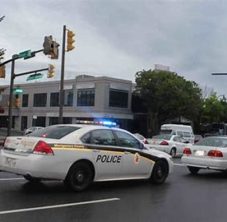The lead image was photographed close to the Montrose Road offramp of the I-270.
There is nothing more stirring, jolting, or heartbreaking than driving by a small memorial marking where a fatal accident occurred. We see them on Old Georgetown Road, Georgia Avenue, and interstate onramps. Was the victim a careless pedestrian looking at an iPhone, an energetic pre-teen trying out a new bicycle, or a toddler who for a critical few seconds left his parents’ line of sight?
Who are the drivers involved in these accidents? Are they self-centered, locomotion narcissists checking their text messages while driving? Were they DUI? Pedantic citizens who never drive above the speed limit?
Who are the people left behind? A parent, child, spouse, or lifelong friend? How far away from the memorial do they live, and what torment do they face with every new day?
All of us slip in and out of any of these categories. Sometimes more than one, and sometimes too frequently.
I don’t know any accident victims directly, but I am two degrees away from two of them: one a College Park student who was foolishly plugged into a smartphone video while jaywalking, another a high-schooler who ran across a busy street to catch a school bus. The first victim wound up in crutches for a few weeks, went on to graduate, get married, and now lives a full life; the second victim wound up in the ICU, and I don’t have the courage to find out what happened after that.
The bloggers here at Clean Slate are all about data, discovery, and setting rational priorities. All that breaks down when it comes to fatalities. By far, more county residents die from heart disease and cancer than from road accidents, so presumably the county should place a higher priority on those causes of death. (In 2022, 19 pedestrians and bicyclists were killed and 541 people seriously injured on the county’s roads. The CDC reports that in 2020, the number of deaths alone from cancer and heart disease was 2,800.) Realistically, the county can’t do much about the residents’ lifestyles that contribute to their deteriorating health. In contrast, the county government can do something about the casualties on its own roads, and do something it must. Just as we have a responsibility to keep our residences and businesses safe for the people who visit them, so the county has a responsibility to keep safe the streets it owns.
The county started installing speed cameras in 2007, with the objective of reducing speed and preventing casualties. Here is the result as reported by the CDC.
It’s hard to conclude much from this graph. Are the speed cameras reducing the death rate per 100,000 residents? Maybe not, so the cameras are only a revenue-generating mechanism. Maybe yes, as the death rate may have been worse without the cameras.
The Safe Streets Act of 2023 is the council’s latest effort to reduce fatalities, and it outlines measures that will hopefully mitigate the scourge.
- Require an infrastructure review for pedestrian-related collisions within a school zone.
- Prohibit right turns on red lights at certain intersections.
- Require traffic control devices at crosswalks in the downtown and town center areas.
- Require the County Executive to provide an automated traffic enforcement plan.
I’ve read some of the detail in this act, and it looks like a lot of micro-control and macro-spending that won’t really address the problem. Hopefully I’m wrong, and time will tell.
There are other measures the county can adopt. One of them is denying cyclists the illusion that they have a right-of-way just because a sign tells them they do. Many of us are familiar with this deceptive sign at the north end of 16th Street.
Signs such as this are possibly encouraging cyclists to place themselves in extremely dangerous situations (although, I’ve never seen a cyclist in this lane of traffic).
Maybe there is nothing we can do about traffic fatalities, and six deaths per 100,000 residents is the best humans can do. As with our many other technological miracles, the vehicles and streets we all so desire come with a painful price that a few people must pay.






